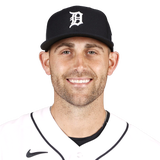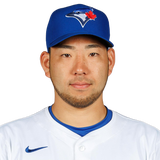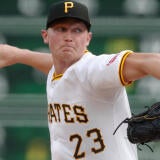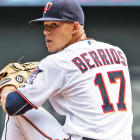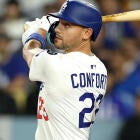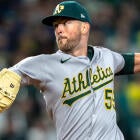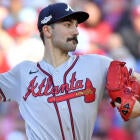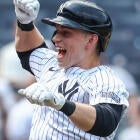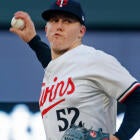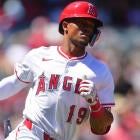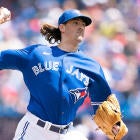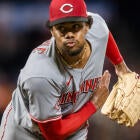Think it's hard to identify hitter breakouts? Try doing it with pitchers, where the term "There's No Such Thing As a Pitching Prospect" exists. TNSTAaPP isn't just for prospects, though: The inherent unpredictability and volatility of the position make knowing who will be good one year vs. the next is nearly impossible.
But only nearly. I wrote about five hitters who need to make adjustments to make the leap to the next level, and we can do the same exercise at pitcher. After all, Frank Stampfl noted a group of pitchers who made potentially overlooked adjustments in 2019 who could pay huge dividends in 2020. Here, we're going to try to do the same, but instead identifying five pitchers who have adjustments left to make, and whether they are likely to make them.
If they do, it could propel them to stardom. Should you make the bet?
| ||||||||||||||||||||
What does he need to change? A better swing-and-miss pitch.
Berrios has always felt like he should be better than he is, and it's because there has always been a difference between how effective his curveball looks and how effective it actually is, at least when it comes to garnering swings and misses. Berrios routinely features on lists of the "nastiest pitches," and it is a visually captivating pitch, with the kind of two-plane movement that just looks unhittable.
But it turns out, it's pretty hittable. Among 137 pitchers who threw at least 100 curveballs last season, Berrios' 12.7% swinging strike rate ranked 57th; not bad, but not good enough when it's your go-to putaway pitch.
Part of the problem with the pitch is, it isn't really a curveball, but it's not a slider either; it falls into that dreaded "slurve" category. It doesn't have the vertical movement you prefer to see from a curveball to tunnel with your high fastballs, and it doesn't have the kind of late break and velocity preferred from a slider.
That leaves Berrios in an interesting place; He's a good pitcher who seems like he should be so much better. Without that elite putaway pitch, he has more in common with someone like Kyle Hendricks than the true aces of the world; he's a command and control specialist who excels at limiting hard contact.
Berrios acknowledges this missing bit of his toolbox and has talked this offseason about trying to improve the curveball and changeup.
Should you expect it? We'll see if that re-worked curve can really make a difference. It's hard to tell from the two spring starts Berrios had, because the broadcast used an off-angle view that made it hard to distinguish. But I did cut some video of two strikeouts by curveball from Berrios, and it definitely looks like there are two breakers here:
Here's a better video showing what look to be two distinct curveballs from Berrios. The first, more of a tight, 12-6/1-7 break, and the second more like the one we've seen in years past. pic.twitter.com/211AQxZQhL
— Chris Towers (@CTowersCBS) May 19, 2020
| ||||||||||||||||||||
What does he need to change? To keep the ball in the yard.
Boyd followed the Patrick Corbin plan in 2019, ditching nearly his entire arsenal except for his four-seam fastball and slider, and it led to a huge increase in his swinging strike and strikeout rates. However, most of those gains were wiped out by a 1.89 HR/9, and it's not hard to see how such extreme fastball and slider usage might have contributed.
The slider wasn't an issue, but the fastball (and occasional changeups and curveballs) was. The answer is, as it was with Corbin, to throw the slider more, though a more varied arsenal wouldn't hurt, and that's what Boyd was showing off in spring training. He spent the offseason working out with Driveline Baseball and their bevy of high-tech tools and cameras to develop the curveball, and it looked great in spring action, and he had more strikeouts with the pitch in his final two spring outings than he did all of last season:
Here's a few fun Matthew Boyd curveball strikeouts from the spring. He has more strikeouts on curveballs in this clip than he had all of last season: pic.twitter.com/4cx2QWhEMn
— Chris Towers (@CTowersCBS) May 19, 2020
Should you expect it? I am. Boyd already has the elite strikeout rate, and control has never been a problem. If he has a third (let alone fourth) with which to keep hitters honest, there's tremendous upside. I like him as a top-30 starting pitcher.
| ||||||||||||||||||||
What does he need to change? A grip.
Diaz's best weapon has always been his slider, and it's been no secret. But that pitch betrayed him last season, as six of his 15 homers allowed came on the slider, leading to a .297 average and .622 slugging percentage against it; in 2018, batters hit .129 with a .234 slugging percentage against the pitch. So, what changed?
Diaz couldn't grip the pitch consistently. That was an issue for plenty of pitchers last season, thanks to the lower seams on the ball, but Diaz might have been impacted more than most. That he wasn't worse than his final numbers given that fact tells you a lot about how good Diaz is.
Should you expect it? Yep. Whether it's from MLB manufacturing the ball more in lines with pre-2019 standards or Diaz just getting used to the seams after a full season and offseason to prepare for it, I'm betting on Diaz to bounce back and once again be one of the best relievers in the game.
| ||||||||||||||||||||
What does he need to change? A better plan.
Ray Searage did a lot right in his time as the Pirates pitching coach, but it became abundantly clear over the last few years that a one-size-fits-all approach just wasn't working, and Keller might be the best example.
Searage's approach was all about keeping the ball down and relying on your fastball, and that's just what Keller did, throwing his 59.5% of the time. The result? Opposing batters lit the pitch up, putting up a .461 average and .719 slugging percentage on the pitch. Keller's fastball has plenty of life to it, but major-league hitters can handle high-90s velocity when they know it's coming. He needs to be less predictable.
Exit Searage, and enter Oscar Marin, a much more sabermetrically inclined coach. Tyler Glasnow, who struggled with the Pirates before emerging as one of the best pitchers in baseball, summed up the issue with the Pirates old approach:
"In Pittsburgh, it was more that they had success in 2013-15 with throwing in and down," Glasnow told The Athletic. "It was pre-advanced stuff, in their defense, to where it was just kind of like, 'This worked in the past. Let's do this,' as opposed to finding the concrete evidence or data to support what your stuff is. If you struggled, they typecast you into a certain role. 'This tends to work, so if you're struggling, here's some stuff that we know works.'"
Keller might have as much talent as Glasnow, and he has two breaking balls that already showed they can be plus pitches even as he struggled in 2019. Armed with a better approach, Keller could break out in a big way.
Should you expect it? I'm betting on it, and not just with Keller; I'm targeting Joe Musgrove and Chris Archer, too.
| ||||||||||||||||||||
What does he need to change? Oh, only everything.
Welp, that isn't promising, but it isn't an exaggeration: Kikuchi was just a mess last season. His velocity disappeared after the first month, and besides his changeup — which he threw almost exclusively to right-handed batters — none of his pitches was all that effective.
Kikuchi recognized the need for improvement, thankfully, and spent the offseason working to improve his delivery, in the hopes of being more consistent and holding his velocity. He was working 94-96 mph consistently in the spring, and that will only help his secondary offerings play up.
Should you expect it?
We know there is talent here, that's why the Mariners gave him the contract they did. If he can hold his velocity, there's room for a significant post-hype breakout, one I'll be buying in the later rounds.
![[object Object] Logo](https://sportshub.cbsistatic.com/i/2020/04/22/e9ceb731-8b3f-4c60-98fe-090ab66a2997/screen-shot-2020-04-22-at-11-04-56-am.png)





